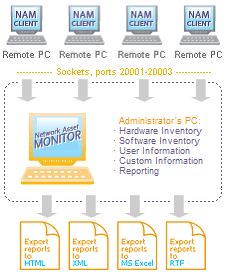
|
Network inventory softwareHardware and software inventory |
|
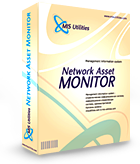 Network Asset Monitor |
|
|
|
|
|
|
Network Asset Monitor - How To Use
Network Asset Monitor Structure
- Network Asset Monitor consists of two parts:
- Network Asset Monitor - User (NAMuser) - runs on user's PC
- Network Asset Monitor - Administrator (NAMadmin) - connects to NAMuser to get information from remote PCs
First start NAMuser on a remote PC and then run NAMadmin on your PC.
System requirements
Platform:
Windows Vista
Windows 2003
Windows XP
Windows 2000
Windows NT
Windows Me
Windows 98
Hardware requirements:
16MB RAM
Pentium-133 MHz
2MB Hard Disk
True Color video mode
Installing Network Asset Monitor
- Run namonitor.exe and follow the setup instructions
- On a user PC, unmark the "Network Asset Monitor - Administrator" component
- On the administrator's PC, unmark the "Network Asset Monitor - User" component
- Set a password for NAMuser
NOTE: You must have administrator rights to begin installation.
NOTE: You can get information from user's PC only if NAMadmin has a password in the "Password store" that is the same as the password in NAMuser on the remote PC. We recommend setting one password for groups of computers or one password for all computers. If you have different passwords for each computer, you must enter all passwords into the "Password store".
After installation, NAMuser will start automatically. NAMadmin can be started from Start menu.
Working with Network Asset Monitor - User
In notification area (system tray) you will see this NAMuser icon: ![]() .
Click the icon and enter the password to work with NAMuser.
.
Click the icon and enter the password to work with NAMuser.
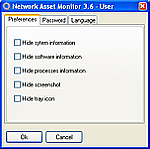
- In the Preferences section, you can hide the following types of information from NAMadmin:
- Hide system information - Data about the user's operating system type and hardware
- Hide software information - Data about the user's software
- Hide processes information - Data about the user's running processes
- Hide screenshot - Screenshots of the user's PC
- Hide tray icon - The NAMuser icon will not be visible in the notification area (system tray)
In the Password section, you can change the current password.
Working with Network Asset Monitor - Administrator
When First Starting
When you first run the program, you must add the users' computers to your list. You can add computers manually one-by-one, or you can run the automatic adding process, which will add all the computers on your network to the list.
To add a computer manually, from the "Computer" menu, select "New Computer". Then type the NetBIOS-name of the computer you want to add.
To run the automatic adding process, from the "Computer" menu, select "Find Computers". NAMadmin will search all computers on your local network and check the version of NAMuser on each.
For adding computers by IP range you must choose menu "Computer" and then click on submenu "Find Computers by IP Range". Then you should type addresses of IP range, you wand to add.
To import computers from the file, you must choose the menu "Computer", and then click on the submenu "Import of Computers from File". You should then choose a file in text format (*.txt), where each line - is a computer name.
On the left side of the NAMadmin window you will see a list of computers with NAMuser version information and the date the information was last updated.
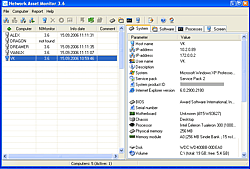
The status bar shows the number of computers on your list.
To delete computers from the list, from the "Computer" menu, select "Delete Computer", or press the Delete key.
To update NAMuser on a remote PC, select it in your computers list and then from the "Computer" menu, choose "Update Version".
Get Inventory Information
Clicking on a computer name in list will show information about the computer in a window on the right-hand side of the screen. Double-clicking will update the information.
To get information about the system on a user's computer, select "System". To get information about software on a computer, choose "Software". To get information about running processes, choose "Process".
To get a screenshot of a user's session, choose "Screen".
To change the type of information collected, from the "Computer" menu, select "View System Info", or "Computer" then "View Software Info", or "Computer" then "View Processes Info".
To send a message to a user's computer, press "Send Message" in the right part of window.
To add passwords in the "Password store" for each NAMuser on your network, from the "File" menu, choose "Options", and then type the password and a description.
To change the language of the interface, from the "File" menu, choose "Options", then "Language".
Add Custom Columns
You can add custom columns to the list of computers in the left side of Network Asset Tracker window. For this choose "File" from the main menu, then choose the submenu "Options". In "Options" form choose "Custom columns".
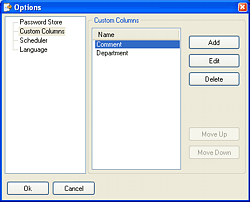
Also you can delete columns or move columns up or down.
Create Inventory Reports
To create reports about all the computers on your list, from the "Report" menu, choose the type of report that you wish to create. You can also create a detailed report including every type of hardware, or you can use a filter to combine any specific types of hardware into one report. You can export any report to MS Excel, HTML, XML, MS Visio XML Drawing or rich text format (RTF).
You can choose the type of report between "List" and "Sheet".
Use Scheduler
You can use scheduler to get information from remote PCs. To do this, choose "File" from the main menu, and then choose the submenu "Options". In "Options" form choose "Scheduler".
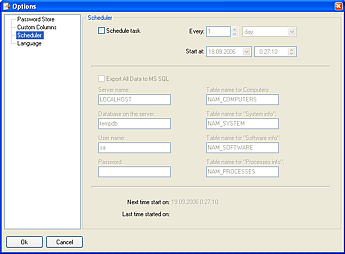
You can set the time and interval for the inventory. Many scheduling options are available, depending on which schedule you use (hour, day, month).
Also you can set automatic export all data to MS SQL. To do this mark checkbox "Export All Data to MS SQL"
You can set the name of MS SQL server, name and password of MS SQL user, name of table for computers, table name for "System info", table name for "Software info" and table name for "Processes info".
| |||||
| |||||
| |||||
|
